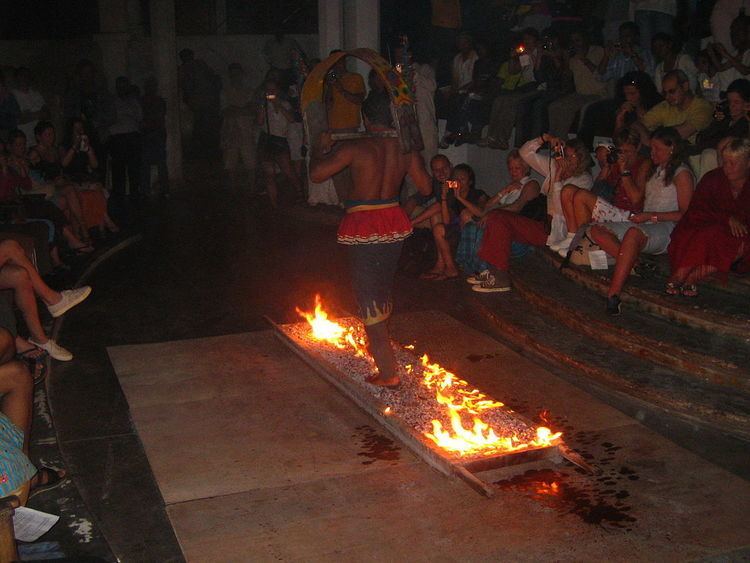 | ||
Firewalking is the act of walking barefoot over a bed of hot embers or stones.
Contents
- History
- Persistence and functions
- Explanation
- Factors that prevent burning
- Risks when firewalking
- References
Firewalking has been practiced by many people and cultures in all parts of the world, with the earliest known reference dating back to Iron Age India – c. 1200 BC. It is often used as a rite of passage, as a test of an individual's strength and courage, or in religion as a test of one's faith.
Modern physics has explained the phenomenon, concluding that the amount of time the foot is in contact with the ground is not enough to induce a burn, combined with the fact that embers are not good conductors of heat.
History
Walking on fire has existed for several thousand years, with records dating back to 1200 BC. Cultures across the globe, from Greece to China, used firewalking for rites of healing, initiation, and faith.
Firewalking is also practiced by:
Persistence and functions
Social theorists have long argued that the performance of intensely arousing collective events such as firewalking persists because it serves some basic socialising function, such as social cohesion, team building, and so on. Emile Durkheim attributed this effect to the theorized notion of collective effervescence, whereby collective arousal results in a feeling of togetherness and assimilation. A scientific study conducted during a fire-walking ritual at the village of San Pedro Manrique, Spain, showed synchronized heart rate rhythms between performers of the firewalk and non-performing spectators. Notably, levels of synchronicity also depended on social proximity. This research suggests that there is a physiological foundation for collective religious rituals, through the alignment of emotional states, which strengthens group dynamics and forges a common identity amongst participants.
Explanation
When two bodies of different temperatures meet, the hotter body will cool off, and the cooler body will heat up, until they are separated or until they meet at a temperature in between. What that temperature is, and how quickly it is reached, depends on the thermodynamic properties of the two bodies. The important properties are temperature, density, specific heat capacity, and thermal conductivity.
The square root of the product of thermal conductivity, density, and specific heat capacity is called thermal effusivity, and tells how much heat energy the body absorbs or releases in a certain amount of time per unit area when its surface is at a certain temperature. Since the heat taken in by the cooler body must be the same as the heat given by the hotter one, the surface temperature must lie closer to the temperature of the body with the greater thermal effusivity. The bodies in question here are human feet (which mainly consist of water) and burning coals.
Due to these properties, David Willey, professor of physics with the University of Pittsburgh, says he believes firewalking is explainable in terms of basic physics and is not supernatural nor paranormal. Willey notes that most fire-walks occur on coals that measure about 1,000 °F (538 °C), but he once recorded someone walking on 1,800 °F (980 °C) coals.
Additionally, Jearl Walker has postulated that walking over hot coals with wet feet may insulate the feet due to the Leidenfrost effect.
Factors that prevent burning
Risks when firewalking
Firewalking is frequently held to imply that the feat requires the aid of a supernatural force, strong faith, or on an individual's ability to focus on "mind over matter".
Since 20th century, this practice is often used in corporate and team-building seminars and self-help workshops as a confidence-building exercise.
